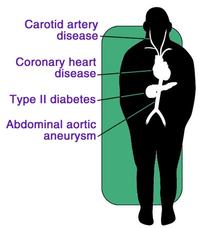Identification of Patients at Very
High Absolute Risk
The following disease
conditions or target organ damage in hypertensive patients denotes the presence
of very high absolute risk that triggers the need for intense risk factor
modification as well as disease management. For example, the presence of very
high absolute risk indicates the need for aggressive cholesterol-lowering
therapy (142).
a. Established coronary heart
disease (CHD)
- History of myocardial
infarction

- History of angina pectoris
(stable or unstable)
- History of coronary artery
surgery
- History of coronary artery
procedures (angioplasty)
b. Presence of other
atherosclerotic diseases
- Peripheral arterial
disease
- Abdominal aortic
aneurysm
- Symptomatic carotid artery
disease
c. Type 2 diabetes
d. Sleep apnea
Identification of other
obesity-associated diseases
Obese patients are at
increased risk for several conditions that require detection and appropriate
management, but that generally do not lead to widespread or life-threatening
consequences. These include:
- Gynecological
abnormalities
- Osteoarthritis
- Gallstones and their
complications
- Stress incontinence
Although obese patients are
at increased risk for gallstones, this risk increases even more during periods
of rapid weight reduction.
| Management options of
risk factors for preventing CVD, diabetes mellitus, and other chronic diseases
are described in detail in other reports. For details on the management
of serum choleserol and other lipoprotein disorders, refer to the National
Cholesterol Education Program's Second Report of the Expert Panel on the
Detection, Evaluation, and Treatment of High Blood Cholesterol in Adults (Adult
Treatment Panel II/ATP II) (1993) (142). For the treatment of hypertension,
the National High Blood Pressure Education Program recently issued the
Sixth Report of the Joint National Committee on Prevention, Detection,
Evaluation, and Treatment of High Blood Pressure (JNC VI) (1997) (545). For the most recent recommendations
about type 2 diabetes from the American Diabetes Asociation, see the ADA
Clinical Practice Recommendations (1998) (546). Finally, smoking cessation is
strongly recommended in obese smokers, with particular attention to methods
that diminish the weight gain associated with cessation. For strategies
and recommendations for supporting and delivering effective smoking cessation
intervention, see the Agency for Health Care Policy and Research's Clinical
Practice Guidelines on Smoking Cessation (547). |
|

